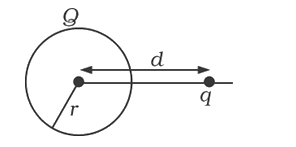A solid sphere of radius R has charge q uniformly distributed over its volume. The distance from it surfce at which the electrostatic potential is equal to half of the potential at the centre is
R
R/2
R/3
2R
The correct Answer is:C
To solve the problem, we need to find the distance from the surface of a solid sphere of radius R with charge q uniformly distributed over its volume, at which the electrostatic potential is equal to half of the potential at the center of the sphere.
1. Calculate the Potential at the Center of the Sphere:
The potential V at a point inside a uniformly charged solid sphere is given by the formula:
V(r)=kq2R(3R2−r2)
where k is Coulomb's constant, q is the total charge, and R is the radius of the sphere. For the center of the sphere, r=0:
Vcenter=kq2R(3R2−0)=3kq2R
2. Determine Half of the Potential at the Center:
We need to find a point P where the potential is half of the potential at the center:
VP=12Vcenter=12(3kq2R)=3kq4R
3. Set Up the Equation for Potential at Point P:
The potential at a distance r from the center of the sphere (where r>R) is given by:
V(r)=kqr
We set this equal to 3kq4R:
kqr=3kq4R
4. Solve for r:
Cancel kq from both sides (assuming kq≠0):
1r=34R
Thus,
r=4R3
5. Calculate the Distance from the Surface:
The distance from the surface of the sphere to point P is given by:
Distance from surface=r−R=4R3−R=4R3−3R3=R3
Final Answer:
The distance from the surface at which the electrostatic potential is equal to half of the potential at the center is:
R3
The potential V at a point inside a uniformly charged solid sphere is given by the formula:
V(r)=kq2R(3R2−r2)
where k is Coulomb's constant, q is the total charge, and R is the radius of the sphere. For the center of the sphere, r=0:
Vcenter=kq2R(3R2−0)=3kq2R
We need to find a point P where the potential is half of the potential at the center:
VP=12Vcenter=12(3kq2R)=3kq4R
The potential at a distance r from the center of the sphere (where r>R) is given by:
V(r)=kqr
We set this equal to 3kq4R:
kqr=3kq4R
Cancel kq from both sides (assuming kq≠0):
1r=34R
Thus,
r=4R3
The distance from the surface of the sphere to point P is given by:
Distance from surface=r−R=4R3−R=4R3−3R3=R3
The distance from the surface at which the electrostatic potential is equal to half of the potential at the center is:
R3
Topper's Solved these Questions
- ELECTROSTATICSBOOK - DC PANDEY ENGLISHCHAPTER - ELECTROSTATICSEXERCISE - JEE Advanced
44 Videos
- ELECTROSTATICSBOOK - DC PANDEY ENGLISHCHAPTER - ELECTROSTATICSEXERCISE - Comprehension
36 Videos
- ELASTICITYBOOK - DC PANDEY ENGLISHCHAPTER - ELASTICITYEXERCISE - Medical entrances s gallery
21 Videos
- EXPERIMENTSBOOK - DC PANDEY ENGLISHCHAPTER - EXPERIMENTSEXERCISE - Subjective
15 Videos
Similar Questions
A solid sphere of radius R has charge q uniformly distributed over its volume. The distance from its surface at which the electrostatic potential is equal to half of the potential at the centre is
View SolutionConsider a sphere of radius R having charge q uniformly distributed insider it. At what minimum distance from surface the electric potential is half of the electric potential at its centre?
View SolutionA solid sphere of radius R is charged uniformly through out the volume. At what distance from its surface is the electric potential 1/4 of the potential at the centre?
View SolutionA sphere of radius R has a uniform distribution of electric charge in its volume. At a distance x from its centre, for x<R, the electric field is directly proportional to
View SolutionA plastic disc of radius 'R' has a charge 'q ' uniformly distributed over its surface. If the disc is rotated with a frequency 'f' about its axis, then the magnetic induction at the centre of the disc is given by
View SolutionA non-conducting sphere of radius R is given a charge Q. Charge is uniformly distributed in its volume. The electric potential at centre and at the surface of sphere respectively are
View SolutionA spherical shell of radius R=1.5cm has a charge q=20μC uniformly distributed over it. The force exerted by one half over the other half is
View SolutionAn insulating solid sphere of radius R has a uniformly positive charge density ρ. As a result of this uniform charge distribution there is a finite value of electric potential at the centre of the sphere, at the surface of the sphere and also at a point out side the sphere. The electric potential at infinity is zero.
Statement-1: When a charge 'q' is taken from the centre to the surface of the sphere, its potential energy changes by qρ3∈0
Statement-2 : The electric field at a distance r(r<R) from the centre of the the sphere is ρr3∈0
View SolutionA solid sphere of radius R has a charge Q distributed in its volume with a charge density ρ=kra, where k and a are constants and r is the distance from its centre. If the electric field at r=R2 is 18 times that r=R, find the value of a.
View SolutionA solid conducting sphere of radius r is having a charge of Q and point charge q is a distance d from the centre of sphere as shown. The electric potential at the centre of the solid sphere is :

View Solution
